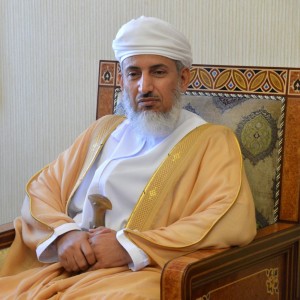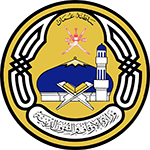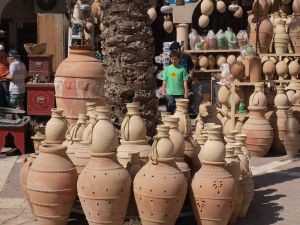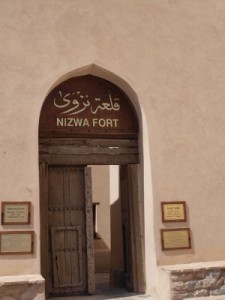 Under the guidance of His Majesty the Sultan Qaboos bin Said, and out of a deep concern for Islamic Art, which encompasses the characteristics of human civilisation and brings to it a unique and special value, the Ministry of Endowments and Religious affairs places particular importance upon Islamic art, and has sought to bring this art into the present age in order to convey the distinct character of Islam. Islamic art is considered to be among he most popular art forms in human civilisation. The present effort considers the great legacy of Islamic art in Oman in order that we may have a glimpse into the history of cultural developments that have taken place over a period of some ten centuries. This has taken place in the understanding that Islamic art is a manifestation of Islamic culture. We employ the term Tslamic7 here to mean that we are dealing with people, their culture, and the influence of their beliefs, experiences, artistic practices, and other areas of human activity on this. We take an approach whereby Oman is compared with other, parts of peninsular Arabia and neighbouring regions, in order that the beliefs, culture, and geographical conditions under examination are clearly defined. The study encompasses all types and styles of Omani art. Firstly, styles which convey the true nature of human civilisation are considered, and then comes the building of places of worship such as mosques, hospices, and prayer rooms. With regard to influences, a clear distinction between the traditional versus the contemporary comes about in the styles of religious constructions of civilised society. Then follow non-religious constructions such as military buildings, which include castles, forts, and residential buildings. Following this is the study of decoration and design, and appreciation of the arts in every shape and style, particularly with regard to the religious, the military, and the residential. With these three types comes the study and use of geometric styles and patterns for decoration, and the materials used for each of them. The writers will devote a chapter to the different designs of mihrabs (prayer niches), which will be examined for different influences in construction, as well as different influences with respect to materials employed in their construction such as timber and ceramic. As the unique Omani style appears on religious and military buildings, so too does this occur in the design of gems and pearls, and other all types of precious decorations, as well as in the traditional manufacture of weapons and metal implements. The authors conclude with a detailed section on distinctions between different regions, their influences and their impact on the Omani identity.
Under the guidance of His Majesty the Sultan Qaboos bin Said, and out of a deep concern for Islamic Art, which encompasses the characteristics of human civilisation and brings to it a unique and special value, the Ministry of Endowments and Religious affairs places particular importance upon Islamic art, and has sought to bring this art into the present age in order to convey the distinct character of Islam. Islamic art is considered to be among he most popular art forms in human civilisation. The present effort considers the great legacy of Islamic art in Oman in order that we may have a glimpse into the history of cultural developments that have taken place over a period of some ten centuries. This has taken place in the understanding that Islamic art is a manifestation of Islamic culture. We employ the term Tslamic7 here to mean that we are dealing with people, their culture, and the influence of their beliefs, experiences, artistic practices, and other areas of human activity on this. We take an approach whereby Oman is compared with other, parts of peninsular Arabia and neighbouring regions, in order that the beliefs, culture, and geographical conditions under examination are clearly defined. The study encompasses all types and styles of Omani art. Firstly, styles which convey the true nature of human civilisation are considered, and then comes the building of places of worship such as mosques, hospices, and prayer rooms. With regard to influences, a clear distinction between the traditional versus the contemporary comes about in the styles of religious constructions of civilised society. Then follow non-religious constructions such as military buildings, which include castles, forts, and residential buildings. Following this is the study of decoration and design, and appreciation of the arts in every shape and style, particularly with regard to the religious, the military, and the residential. With these three types comes the study and use of geometric styles and patterns for decoration, and the materials used for each of them. The writers will devote a chapter to the different designs of mihrabs (prayer niches), which will be examined for different influences in construction, as well as different influences with respect to materials employed in their construction such as timber and ceramic. As the unique Omani style appears on religious and military buildings, so too does this occur in the design of gems and pearls, and other all types of precious decorations, as well as in the traditional manufacture of weapons and metal implements. The authors conclude with a detailed section on distinctions between different regions, their influences and their impact on the Omani identity.
With regard to the contents outlined above, the book on Islamic Art in Oman benefits greatly from many discoveries and developments that have taken place over the past two decades, from the
renewed awareness of the great value of the Omani art and architecture to new techniques in the field of archaeology. From these, this work promotes cultural renewal, enlightenment, and an awareness of civilisation, beauty, and progress. In conclusion, we wish to convey our great appreciation to all who participated in this work. May God Almighty bless us and help us all.
Sheikh Abdallah bin Mohammed bin Abdullah Al Salmi
Former Minister of Endowments and Religious Affairs




